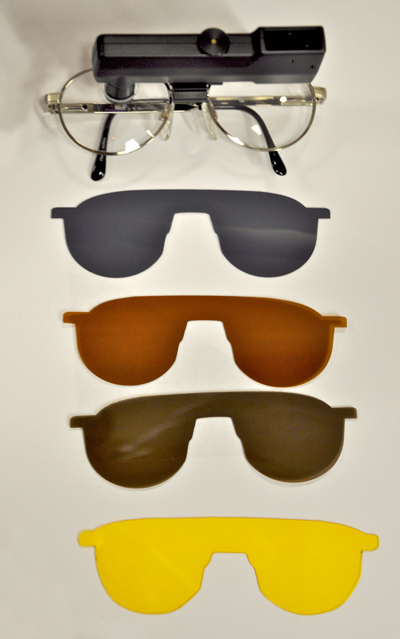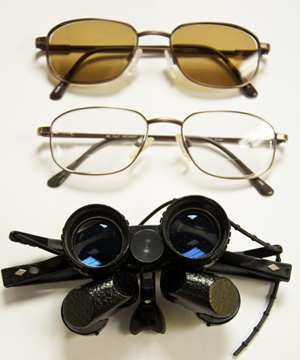"There are two kinds of light - the glow that illumines, and the glare that obscures."
- James Thurber
Glare and the Bioptic Driver
Problems with light and glare can endanger any driver. Uncontrolled glare may mask oncoming traffic and limit the ability to see signs and brake lights. Glare control is one of the most critical issues that must be dealt with for safe bioptic driving. Not controlling glare can lead to failure of an otherwise good bioptic driving candidate or make the driver less safe on the road.
Low vision patients vary on their light sensitivity. Some conditions require much more stringent control of light and glare. Safe bioptic driving requires a combination of careful control of glare and anticipation of potential glare problems.
The low vision specialist will determine the degree of glare problems and appropriate treatments including sun filters, hats, visors and other adaptive steps. The low vision specialist may advise some patients to avoid driving just after sunrise and just before sunset, where low-lying sun might cause significant glare problems.
Glare Problems in Bioptic Driving
Photostress or Poor Glare Recover: When the energy of light bleaches out the chemicals in the retina, a temporary decrease in vision may occur. We all experience a brief form of this when we have a flash picture taken and notice a temporary spot in our vision. Patients with central retinal disorders like macular degeneration and Histoplasmosis may bleach-out severely and not quickly recover to their base vision
Discomfort Glare or Photophobia: Discomfort glare is the visual discomfort or pain caused by very bright light such as direct sunlight or bright lamps. It can vary from mild annoyance to overwhelming pain.
Disability glare: Disability glare is the situation where vision is impaired by excessive dazzle from a bright light source or reflection such as light reflecting from a glossy surface or from water. The degree of this impairment can vary from minor low contrast veiling glare across the vision to severe temporarily blinding glare.
Use of Selective Sun Filters in Bioptic Driving
 Proper sunglasses are helpful for most drivers, but critical for low vision patients who are often more easily impaired by glare. The low vision specialist can determine the proper type of filter. The color and properties of the filter are important. Many patients with retinal disorders do better with amber/blue blocker colors that reduce blue light. Sunglasses must be adapted to the type of bioptic utilized.
Proper sunglasses are helpful for most drivers, but critical for low vision patients who are often more easily impaired by glare. The low vision specialist can determine the proper type of filter. The color and properties of the filter are important. Many patients with retinal disorders do better with amber/blue blocker colors that reduce blue light. Sunglasses must be adapted to the type of bioptic utilized.
Bioptic Driving Sun filters
In fitting the Ocutech Sport we prescribe four filters for the patient to slip-in behind the carrier eyewear. These include a yellow filter, which helps some patients on overcast, foggy or rainy days and blue light reduction filter, brown and gray filters for the patient to experiment on their needs in different situations. Two dark filters can be riveted together to create a much darker filter if needed.
Additionally in patients more affected by glare, a small slip-on sun filter can be snapped over the front objective of the bioptic to control glare through the telescope. This also can be quite helpful for the bioptic driver with a required driving path towards the low-lying sun such an evening drive home from work.
 In fitting the Beecher Mirage we use two separate sets of regular eyewear with little or no tint and sun wear. One is for low light level such as overcast days and evening. The other is a sun filter for bright light.. We avoid a slip in sunglass as it adds a needless third movable element to the system. Filter caps for the objective lenses can be prescribed if needed.
In fitting the Beecher Mirage we use two separate sets of regular eyewear with little or no tint and sun wear. One is for low light level such as overcast days and evening. The other is a sun filter for bright light.. We avoid a slip in sunglass as it adds a needless third movable element to the system. Filter caps for the objective lenses can be prescribed if needed.
